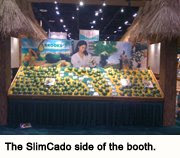Article and recipe courtesy of the Centre Daily Times, State College, PA. Thursday, Nov. 20, 2008
Makes 8 servings plus 1 cup additional dressing
We're coming to the end of the season for Florida avocados. They're still the major commercial fruit crop in Miami-Dade, according to agricultural extension agent Mary Lamberts, who notes that they have 25 to 30 percent fewer calories, ounce for ounce, than their California cousins.
Do ahead: The dressing can be refrigerated for up to 3 days. The bacon can be fried and refrigerated several days ahead.
DRESSING
• ½ to 1 ripe Florida avocado depending on size, coarsely chopped (about 1 ½ cups)
• 1 cup buttermilk
• 2 tablespoons white-wine vinegar
• 2 small shallots, peeled and coarsely chopped
• 1 tablespoon coarsely chopped flat-leaf parsley
• 2 small garlic cloves, smashed and peeled
• 1 teaspoon kosher salt
• ½ teaspoon freshly ground pepper
• ¾ cup extra-virgin olive oil
SALAD
• 1 pound bacon, cooked until crisp, drained and broken into 1-inch pieces
• 1 ripe Florida avocado cut into thin wedges
• 1 pound mesclun salad mix
To make the dressing, combine the chopped avocado, buttermilk, vinegar, shallots, parsley, garlic, salt and pepper in a blender; process until smooth. With the motor running, add the olive oil in a thin stream and process until smooth.
To make the salad, toss the mesclun with the bacon in a large bowl. Add ½ cup dressing and toss until evenly coated. (Refrigerate remaining dressing for later use.)Season the salad with salt and pepper and mound on 8 salad plates. Tuck avocado wedges into greens.
Per serving dressed salad: 383 calories (73 percent from fat), 31.3 g fat (10.1 g saturated, 17.3 g monounsaturated), 67.8 mg cholesterol, 19.4 g protein, 6.7 g carbohydrates, 2.9 g fiber, 1,523 mg sodium.
Per tablespoon dressing: 81 calories (90 percent from fat), 8.1 g fat (1.2 g saturated, 5.7 g monounsaturated), 0.4 mg cholesterol, 0.7 g protein, 1.9 g carbohydrates, 0.7 g fiber, 89.1 mg sodium.
 Alberto Bonilla, director of sales for Ujarras, Costa Rica-based B&C Exportadores, made the front page of this week’s The Packer.
Alberto Bonilla, director of sales for Ujarras, Costa Rica-based B&C Exportadores, made the front page of this week’s The Packer.





 Our Kumquat grower offers an alternative to a key lime pie.
Our Kumquat grower offers an alternative to a key lime pie.




